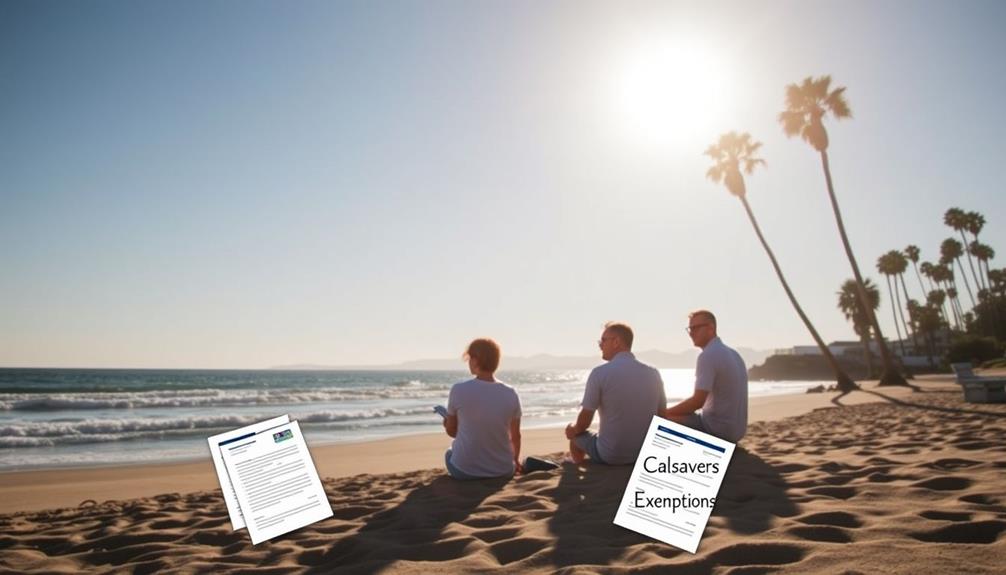Retirement planning in California involves incorporating IRAs with state-specific benefits such as the CalSavers program. This program automatically enrolls eligible employees in Roth IRAs if their employer does not offer a retirement plan. Participants will enjoy a default contribution rate and the option to choose between Roth and traditional IRAs. Additionally, CalSavers aims to bridge the retirement savings gap that impacts many Californians. Adhering to registration deadlines is crucial to avoid penalties. Knowing how to maximize IRA options in conjunction with these state benefits can boost your financial security during retirement. Explore more about these tactics to safeguard your future.
Key Takeaways
- CalSavers requires California employers without retirement plans to enroll employees in Roth IRAs by December 31, 2025, enhancing access to retirement savings.
- Employees can contribute a minimum of $10 via payroll deductions, with a default rate starting at 5%, increasing annually.
- IRA options allow for personalized tax treatment, with traditional and Roth IRAs offering flexibility based on individual financial situations.
- Employers face escalating penalties for non-compliance with CalSavers, starting at $250 per employee after 90 days.
- The program addresses California's retirement savings gap, providing important resources and support for both employers and employees.
Understanding CalSavers Program

The CalSavers Program is California's innovative solution to boost retirement savings among employees. If you're an employer without a retirement plan, you're required to automatically enroll your eligible employees in Individual Retirement Accounts (IRAs), specifically Roth IRAs. This means that your employees will benefit from a straightforward way to save for retirement.
To comply, you must register for CalSavers by specific deadlines based on your employee count. Failing to do so can lead to fines of $250 per employee after 90 days, escalating to $500 after 180 days.
Once enrolled, employees can contribute a minimum of $10 through payroll deductions, with a default contribution rate starting at 5% of gross pay. This rate automatically increases by 1% each year, capped at 8%.
The program is designed to help narrow the retirement savings gap in California's workforce. Employees have the flexibility to opt-out at any time, and their accounts remain portable, ensuring continuity even if they change jobs.
Employer Participation Requirements

Registering for CalSavers is an essential step for employers in California, especially those with at least one employee. If you're an employer who doesn't already offer a qualified retirement plan, you need to register for CalSavers.
Registration deadlines depend on the size of your business, but all employers must comply by December 31, 2025.
As an employer, you're responsible for maintaining an up-to-date employee roster and facilitating program enrollment and contributions. It's important to guarantee that your employees can participate in this retirement savings plan through employee payroll deductions.
Remember, you won't be making contributions to CalSavers accounts; participation is solely funded by the employees.
Non-compliance with CalSavers can lead to serious consequences, including escalating fines of $250 per employee after 90 days and $500 after 180 days.
To avoid these fines, stay proactive about your registration and make certain your employees are informed about their options under the CalSavers program.
Benefits for Savers

Participating in CalSavers provides numerous advantages for savers looking to secure their financial future. With automatic enrollment, employees are set up at a default contribution rate of 5%, which increases annually by 1% up to 8%. This nudges you toward greater savings without requiring constant action.
Additionally, incorporating options like a Gold IRA can greatly enhance your retirement strategy, especially in a volatile economy where diversification of retirement portfolios is essential.
Here are some key benefits of CalSavers:
- Flexibility: You can choose between Roth and traditional IRA options, allowing for tailored tax treatment of your contributions and withdrawals.
- Low Investment Fees: With fees ranging from 0.825% to 0.99%, more of your money goes toward growing your retirement savings.
- Portability: The IRAs you establish through CalSavers are portable, meaning you can keep your savings intact even if you change jobs.
Exemptions From Calsavers

If you're an employer in California, understanding the exemptions from CalSavers is important for managing your retirement plan obligations. You may qualify for exemptions if you sponsor a qualified retirement plan, such as a 401(k), or if your organization fits specific classifications like government or religious entities.
To request an exemption, it's necessary to submit your eligibility criteria by the registration deadlines of December 31, 2024, and December 31, 2025.
Keep in mind that monitoring your employee data is essential; changes in this data could affect your exemption status. Non-compliance with the exemption criteria could force you to register for CalSavers, which means you'll need to provide retirement benefits to your employees under the program.
Failing to maintain an up-to-date employee roster can lead to penalties and may jeopardize your eligibility for exemptions. Staying informed about these requirements and deadlines will help you avoid potential fines and guarantee you're fulfilling your obligations.
Comparing IRAs and 401(k) Plans

Steering through retirement options can be overwhelming, especially with the various plans available. When comparing IRAs and 401(k) plans, it's crucial to understand their key differences to make informed decisions for your retirement savings.
Many investors are now exploring precious metal IRAs, which can provide a hedge against inflation and market volatility, making them an attractive option for retirement portfolios. Look into trusted Gold IRA providers to enhance your investment strategy.
- Contribution Limits: IRAs, including traditional and Roth options, allow you to contribute up to $7,000 annually (or $8,000 if you're 50+). In contrast, 401(k) plans have higher limits of $23,000 ($30,500 for those 50+).
- Employer Contributions: 401(k) plans often include employer contributions, boosting your retirement savings, while IRAs are typically funded solely by your personal contributions.
- Tax Implications: Traditional IRAs may offer tax-deductible contributions, whereas Roth IRAs use after-tax dollars, leading to tax-free withdrawals in retirement. 401(k) contributions can also be pre-tax, reducing your taxable income.
Additionally, note that 401(k) plans usually require mandatory participation under state mandates like CalSavers, whereas IRAs don't have this requirement.
Understanding these distinctions helps you choose the best option tailored to your retirement goals.
Importance of Retirement Planning

Retirement planning isn't just a good idea; it's essential for guaranteeing your financial security in later years. With nearly 40% of California workers lacking access to employer-sponsored retirement plans, initiatives like CalSavers play an important role in enhancing savings opportunities. Understanding the importance of retirement planning can deeply impact your future.
| Factor | Statistics | Impact on Employees |
|---|---|---|
| Access to Employer-Sponsored | 40% lack access | Increased savings by 15-20% |
| Participation in CalSavers | 79% find benefits essential | Attracts small businesses |
| Retirement Savings Gap | Over $14 trillion | Addresses savings crisis |
Employees who participate in retirement plans are considerably more likely to save effectively. As small businesses focus on offering retirement benefits, they not only attract talent but also help employees secure their future. By taking advantage of initiatives like CalSavers, you can gain access to vital retirement savings options. Prioritizing retirement planning now guarantees that you'll enjoy a more comfortable and secure retirement down the road.
Navigating Compliance and Penalties

As the deadline approaches for California employers to register for CalSavers, understanding compliance and penalties becomes vital. If you haven't registered by December 31, 2025, you could face fines of up to $750 per employee for non-compliance.
It's important to act quickly, as the penalties escalate if you fail to register within 90 days—starting at $250 per employee and increasing to $500 after 180 days.
To help you navigate these requirements, keep in mind:
- Eligible Employees: All employees must be enrolled in CalSavers if you don't offer a qualified retirement plan.
- Exemptions: Companies with a qualified retirement plan can request exemptions, but be mindful of the deadlines—December 31, 2024, and December 31, 2025.
- Maintaining Compliance: Regularly update your roster and guarantee all participation requirements are met to avoid penalties.
Being proactive about your registration won't only help you steer clear of fines but also contribute to a more secure California retirement landscape for your employees.
Don't wait until it's too late; prioritize compliance now!
Resources for Employers and Employees

Accessing the right resources can make all the difference for employers and employees participating in CalSavers. This program offers dedicated client services that help you navigate enrollment and compliance with ease.
As an employer, you can access a wealth of educational resources, including informational sessions and meetings that clarify retirement savings options for you and your employees.
You'll find testimonials from other business owners who share how CalSavers positively impacted their employee recruitment and retention. By leveraging these insights, you can further enhance your workplace culture and support your team's financial wellness.
For up-to-date information about program developments, deadlines, and vital resources, the CalSavers website is your go-to hub. Staying informed is essential for both employers and employees as you make retirement planning decisions.
If you need help, dedicated support is readily available through dedicated phone lines and email. This guarantees you can receive guidance whenever you need it.
Utilizing these resources can empower you and your employees to maximize your CalSavers experience and build a secure retirement.
Frequently Asked Questions
What Is the California State Law Regarding Retirement Plans?
California law mandates that employers with one or more employees must register for CalSavers if they lack a retirement plan. You'll face penalties for non-compliance, so make certain you enroll your employees by the deadline.
How Does Retirement Work With the State of California?
Retirement in California's like discovering a treasure chest! You'll navigate options like CalSavers for easy IRA contributions, enjoy automatic enrollment, and choose between Roth and traditional IRAs, ensuring your future's as bright as the California sun.
What Is the Reciprocity for California Pensions?
Reciprocity for California pensions lets you transfer service credits between states with similar systems. If you've worked in another participating state, you can combine your service time for a better pension benefit when moving to California.
Is Calsavers a Good Idea?
You might feel overwhelmed by retirement planning, but CalSavers offers a practical solution. With automatic enrollment and flexible IRA options, it's a smart choice for enhancing your savings without burdening your employer.
Conclusion
As you commence your retirement journey in California, think of your savings as seeds planted in fertile soil. By integrating IRAs with state-specific benefits like CalSavers, you're nurturing your financial future. Each contribution is a step toward a thriving garden of security and comfort. Don't let compliance challenges overshadow your growth; instead, cultivate your knowledge and resources. With careful planning, you can reap a bountiful harvest when it's time to enjoy the fruits of your labor.










